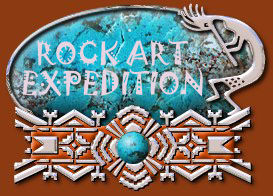

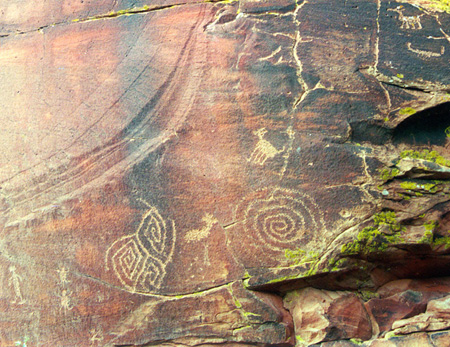 Spirals are thought to represent the
people moving into an area (clockwise spirals) or leaving an area (counter-clockwise
spirals).
Spirals are thought to represent the
people moving into an area (clockwise spirals) or leaving an area (counter-clockwise
spirals).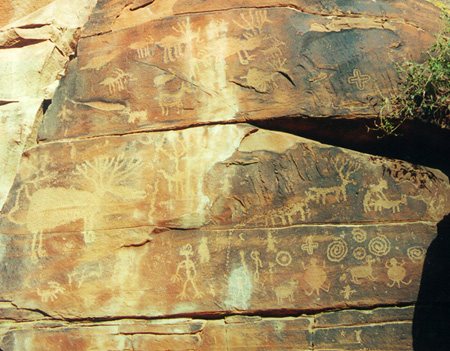 A large collection of moose and
other petroglyphs. In particular, note the cross near the upper right and
elsewhere. Crosses are quite prevalent in rock art. There are also more
spirals, a person with exaggerated hands and feet, turtles and two animals copulating near
the middle right.
A large collection of moose and
other petroglyphs. In particular, note the cross near the upper right and
elsewhere. Crosses are quite prevalent in rock art. There are also more
spirals, a person with exaggerated hands and feet, turtles and two animals copulating near
the middle right.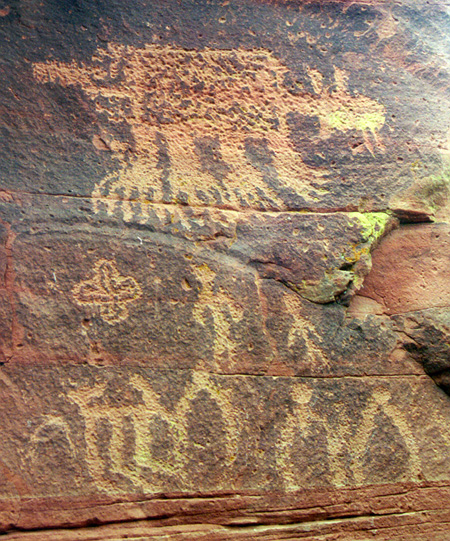 The
animal at the top is thought to be either an exaggerated mountain lion or a saber-tooth
tiger. If it's the latter, these carvings would be very old indeed. There is
yet another cross. The three "wishbone" shapes at the bottom are actually
thought to be shaman with exaggerated arms which are perhaps grounding them as they travel
astrally (represented by the people floating above them) to a dangerous place (represented
by the frightening feline with the exaggerated claws and fangs).
The
animal at the top is thought to be either an exaggerated mountain lion or a saber-tooth
tiger. If it's the latter, these carvings would be very old indeed. There is
yet another cross. The three "wishbone" shapes at the bottom are actually
thought to be shaman with exaggerated arms which are perhaps grounding them as they travel
astrally (represented by the people floating above them) to a dangerous place (represented
by the frightening feline with the exaggerated claws and fangs).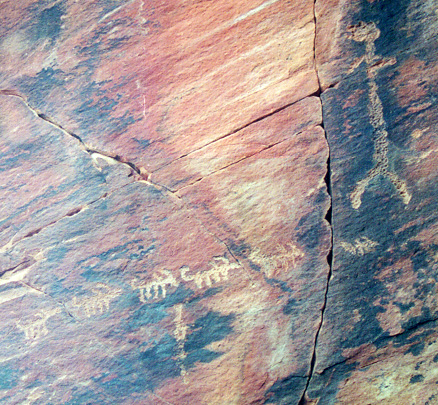 The Tallman and a herd of animals. The Tallman figures prominently in the
legends of the Hopi. Hopi Indian legends and life ways suggest that the Southern
Sinagua,
a prehistoric people of the Sedona region who are thought to be responsible for much of
the rock art in the Sedona region, may have joined them on their mesas to the northwest
when the Sinagua abandoned the Verde Valley in the early 1400s.
The Tallman and a herd of animals. The Tallman figures prominently in the
legends of the Hopi. Hopi Indian legends and life ways suggest that the Southern
Sinagua,
a prehistoric people of the Sedona region who are thought to be responsible for much of
the rock art in the Sedona region, may have joined them on their mesas to the northwest
when the Sinagua abandoned the Verde Valley in the early 1400s. A Shaman wearing a headdress and some
kind of animal.
A Shaman wearing a headdress and some
kind of animal.




© All pictures are Copyright 1999 - 2001 Grisel Gonzalez